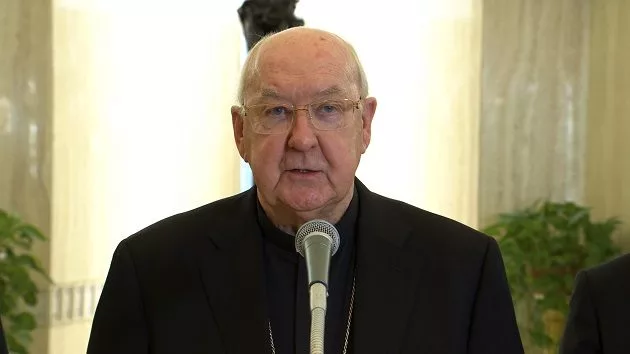(VATICAN CITY) — Who was the very first pope? How many popes have there been? Has anyone ever refused the office?
For an institution that has existed for nearly 2,000 years, most people know very little about the papacy and its history. Here are some of the most commonly asked questions – and a few answers you may find surprising.
Who can be pope?
Canon law says any unmarried, baptized male Catholic, clergy or not, is eligible to be pope. That said, only cardinals have been elected for the last 600-plus years, so being considered for the position in this case is very much the result of whom you know.
Who was the very first pope?
The first pope was St. Peter, after whom St. Peter’s Basilica in Vatican City is named. St. Peter wasn’t elected, however, being said by the church to have been appointed by Christ. In fact, all popes were essentially appointed for about the first thousand years; even if the church selected a successor, that selection had to be approved by a secular party or parties – think monarchs, heads of state and other power brokers – a process that made choosing the next pope both fractious and extremely political.
It’s generally accepted that the papal election process as we currently recognize it began with Pope Nicholas II, the 155th pope, who in 1059 issued a landmark bull, or edict, that contained major church reforms, among them giving the sole power of papal election to the College of Cardinals – a responsibility they retain to this day.
How many popes have there been?
Pope Francis, elected in 2013, who died on Monday, was the 266th pope in the Catholic Church’s roughly 2,000-year history, which spans three millennia. However, that count comes with qualifications.
There were nearly 40 popes who were considered to be illegitimate for various reasons, mostly because they were appointed by secular rulers or warring factions within the church itself, and so aren’t officially counted by the Vatican. The last of these so-called antipopes was Felix V, whose roughly nine-and-a-half-year reign ended in 1449.
There also were five interregnums – that is, periods without a pope and no active papal selection process – the first in the late 13th century and the most recent ending in March 1800, totaling 10 years and 50 days.
Has anyone ever rejected being elected pope?
Has anyone ever rejected being elected pope?It’s rare, but it has happened. The first person known to have done so was St. Philip Benizi, in 1271, who reportedly was so opposed to being elected that he ran away and hid until another candidate was chosen. The late 16th century St. Charles Borromeo, one of the few cardinals to be canonized, also refused the papacy, though in less dramatic fashion.
Most recently, when Cardinal Giovanni Colombo, the 76-year-old archbishop of Milan, began receiving votes during the conclave in October 1978, he reportedly made it clear that he would refuse the papacy if elected. Cardinal Karol Józef Wojtyla, Archbishop of Kraków, was ultimately elected pope and took the name John Paul II.
Why do popes change their names, and do they have to?
Short answer? Tradition. In fact, immediately after affirming that he accepts his election, the ceremonial second question a new pope is asked is, “By what name shall you be known?”
That said, no pope is required to change their name upon election, and for more than a thousand years, few did. The first pope to change his name was the Roman-born 56th pope, John II, elected in the year 533, who felt that using his birth name – Mercurius – was inappropriate because of its association with the Roman god Mercury. He chose John II in honor of his predecessor, Pope John I, the 53rd pontiff.
Even so, the practice of choosing a papal name remained inconsistent for the next 1,000 years, with most popes using their baptismal names. Taking a papal name became more common as the centuries passed, with some non-Italian popes doing so for no more complex a reason than to make it something easier for Romans to pronounce.
Pope Marcellus II, elected in 1555, was the last to use his baptismal name. His successor, Giovanni Pietro, chose the papal name Paul IV, and the practice has continued uninterrupted since. The tradition is now seen as a way for the new pope to signal which of his predecessors he will emulate.
However, although most popes select a predecessor’s name, they are not obliged to do so. Pope Francis bucked that tradition when he was elected, instead choosing his name to honor St. Francis of Assisi, the 13th century cleric now celebrated in the church as the patron saint of animals and the environment. Pope Francis said St. Francis inspired him as “the man of poverty, the man of peace, the man who loves and protects creation.”
Interestingly, there have only been two popes to take a double papal name, both of them in the 20th century and both back-to-back. John Paul I was the first to do it, in August 1978, and was also the first to intentionally include the designation ‘the first’ in his papal name. Upon his unexpected death less than two months later, John Paul I’s successor, Karol Wojtyla, chose the name John Paul II to honor him.
What are the most-used papal names?
With 266 popes and 2,000 years of history, there are plenty of papal names from which new popes can choose. There are, however, some clear favorites.
The most popular papal name, by far, is John: 23 popes have taken it. The first was John I, the 53rd pontiff, in 523; the most recent was John XXIII, the 261st pope, elected in October 1958.
In second place is Gregory, with 16 uses, the first in 590 and the most recent in 1831. Benedict is tied for second, also with 16 uses, with the most recent being Pope Francis’ predecessor, Benedict XVI. Some purists, however, insist there were only 15 Benedicts, purposely omitting Benedict X, who was elected in 1058 but later determined to be an antipope and replaced in less than a year by Nicholas II.
Following Gregory and Benedict, there have been 14 Clements, 13 Innocents, 13 Leos, and 12 popes to use Pius. It’s single-digits from there on, with 44 out of 266 papal names used only once. Chief among the single-use names is Peter, being St. Peter, the first pope – a name that, per tradition, is unlikely ever again to be used.
Who was pope for the longest/shortest time?
The church officially recognizes St. Peter, the first pope, as the longest-serving, with at least 34 years. However, many historians dispute that as impossible to verify, and instead say the longest-serving pope was Pius IX, who held the office just shy of 32 years, until his death in February 1878.
The record for shortest time as pope goes to Urban VII, who died of malaria in September 1590 after just 13 days in office.
Who was the youngest/oldest pope?
At 81 years old, Pope Gregory XII was the oldest pope at time of election, in November 1406. The youngest was John XII, who is believed to have been just 18 years old when he was elected in 955 as the 130th pope.
The longest-lived pope, active or former, was Benedict XVI, who resigned the papacy in February 2013 at age 85 and was 95 years old when he died Dec. 31, 2022. Having turned 78 just three days before he was elected pope in April 2005, he also was the fifth-oldest pope in history when he accepted the office.
Of the nine popes who reigned in the 20th century – beginning with Leo XIII, whose papacy ended in 1903 – their average age at the time of election was 65. Of those, John XXIII was the oldest, at 76, and John Paul II the youngest, at 58. The average age of the 62 popes elected since 1400 is 62.4 years. Any age data prior to 1400 is considered largely unreliable.
Bonus fact: Who makes the pope’s clothes?
The liturgical garments – such as robes, stoles and hats – worn by the pope and other Christian church officials are known as vestments. Since 1798, the pope’s vestments have been manufactured by the Gammarelli family tailors in Rome, who first made the garments for Pope Pius VI. They also make off-the-rack liturgical garments for clergy other than the pope, but the election of a new pope requires special attention.
While a new pope is being chosen, the Gammarellis prepare three sets of vestments in small, medium and large sizes so they will be ready to be worn immediately by the new pope, who makes his first public appearance within hours of election. Once he’s elected, the Gammarellis make bespoke vestments for him, though the pontiff has the option of obtaining his vestments elsewhere if he so chooses.
Despite the care taken, those ready-to-wear initial papal vestments didn’t always do the trick. Pope John XXIII, who was five feet, six inches tall and weighed close to 200 pounds when elected in 1958, donned the small-size vestments by mistake for his first public appearance, requiring attendants to slit them up the back so that they appeared to fit from the front. Conversely, the athletic Pope John Paul II – five feet, ten inches tall and broad-shouldered – is said to have barely been able to fit into the large-sized vestments for his first public appearance.
ABC News’ Phoebe Natanson contributed to this report.
Copyright © 2025, ABC Audio. All rights reserved.

